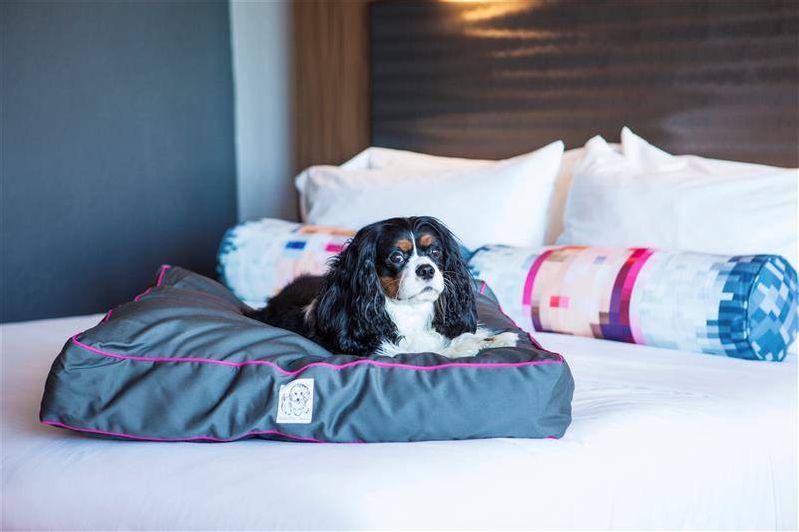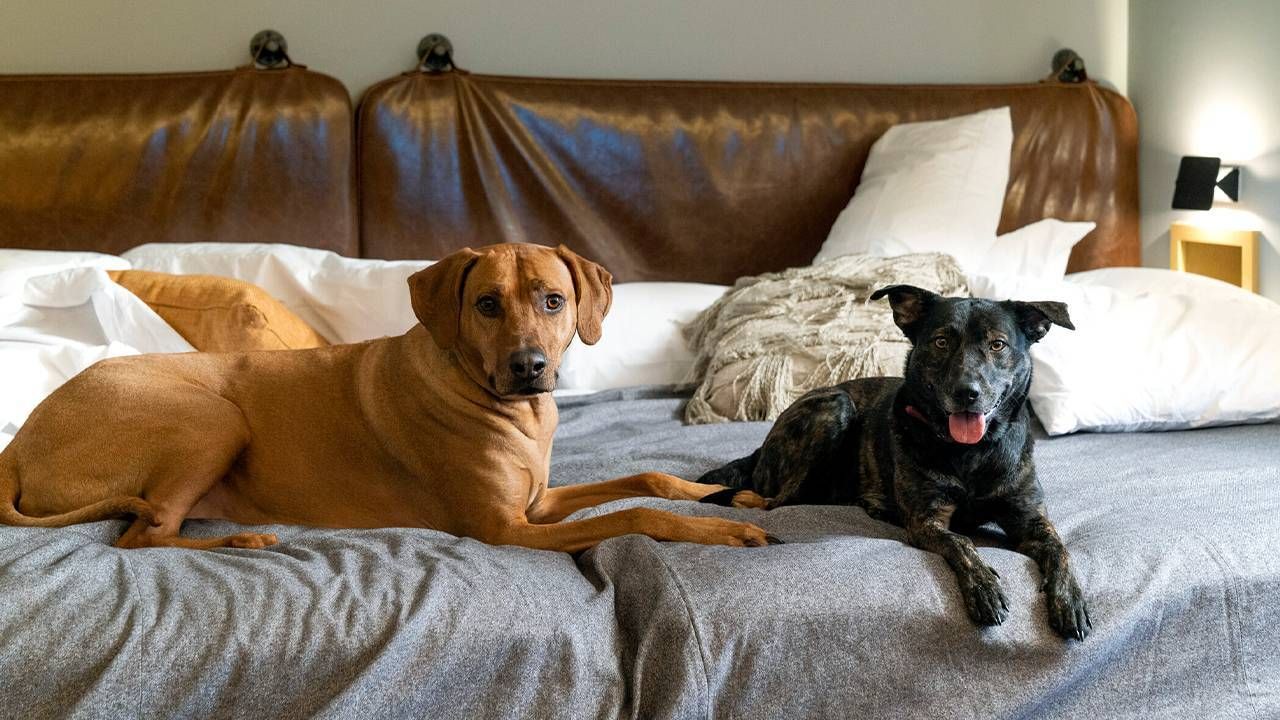Dogs, Planes, Hotels and Automobiles
Tips on hotel stays and ways to prepare for traveling with your four-legged friend
According to the ASPCA (The American Society for the Prevention of Cruelty to Animals), the COVID-19 crisis spurred some 23 million households to acquire a pet.
It's no surprise that man's new best friend will be a part of the family's next adventure. And as more Americans are making travel plans, many are looking for trips that can accommodate their beloved four-legged family members.

However, taking Rover along on a family trip necessitates research and planning.
Will your dog be a good travel companion? "Be honest with yourself that your dog can travel and be sure that where you are going is accepting and safe," says Dr. Douglas Kratt, a veterinarian and president of the American Veterinary Medical Association. Before leaving home, discuss your travel plans with your vet.
During the pandemic, dogs and their owners have likely spent a great deal more time together bonding and establishing their household routines. While humans enjoy the excitement of visiting a new destination and reconnecting with family or friends, dogs might need some assistance adapting to a new environment.
Where Is Your Pet Welcome?
Growing numbers of hotels now welcome pets. But be aware that policies and fees can vary even within the same brand.
To determine if a hotel is pet-friendly, review the website or call the property directly.
For example, Hyatt Place in New Orleans charges a pet fee of $75 for guests who stay one to six nights. The hotel permits a maximum of two dogs with a combined weight of 75 pounds or one dog under 50 pounds.However, the New York Hyatt in Times Square does not allow pets.
To determine if a hotel is pet-friendly, review its website or call the property directly.
When you are booking a hotel, use the brand's website and click on the "pet-friendly" filter — typically found under an "amenities" heading — to locate appropriate properties. (Now, you can even bring your dog to Las Vegas.)
Another easy-to-use search tool is the BringFido app and site. This handy tool, updated regularly, filters hotels by a range of criteria including: no pet fee, a low pet fee (under $25), allows large dogs (over 50 pounds ) and accommodates multiple pets.
The size of your dog may affect your accommodation choice. The Kimpton hotel chain accepts dogs of any weight. Best Western allows dogs that weigh up to 80 pounds. Motel 6 and Studio 6 properties permit two dogs per room — as long as the combined weight is under 150 pounds.
Most hotels that allow pets do charge for bringing them. Read the fine print; some fees are a one-time expense for the length of your visit, while others are imposed daily and some are per dog.

A few hotel and motel brands don't charge at all, however. Motel 6 and Studio 6 have more than 1,400 U.S. hotels where dogs stay for free. Aloft, a Marriott brand, not only doesn't charge, but provides each canine guest with a complimentary Animals R Fun (ARF) kit which includes their own bowl, picker-upper bags, treats, a dog tag, pet toys and a bed.
Kimpton, an IHG (InterContinental Hotel Group) brand, allows furry guests to stay at no charge and provides a list of items, such as a water bowl, that can be borrowed (some restrictions apply).
When staying at a hotel, ascertain its policies about dogs being left in your guest room unattended.
At Home2 Suites by Hilton, staff will not clean a room if a dog is unattended or not in a crate; it will work with the guests to schedule a cleaning time. Motel 6 and Studio 6 require guests and their pets be out of the room for it to be cleaned.
Hotels located near parks or green spaces hold a special appeal for pet owners and some offer special features. At Loews Hotels, guests receive a dog-walking map and recommendations to pet sitting services, pet-friendly dining and nearby parks. They even supply the doggie pick-up bags.
Dogs on the Road
For road trips, get your dog acclimated to riding in a car well in advance of your journey. If your dog has only spent five or 10 minutes at a time riding in a vehicle, Kratt suggests testing their road tolerance by taking some short trips near your home to see how your pet deals with the drive.
Remember, dogs need to be securely restrained in cars— preferably in crates. Do not let them hang their heads out a window and never leave an unattended animal in a car. "It takes no time at all for a vehicle to heat up to temperatures that could be deadly," says Kratt.
Dogs in the Air
Choosing to fly with your pet involves assessing a variety of factors. The size of your dog determines where he will ride. A dog that is small enough to fit in a carrier may travel underneath the seat in front of you (though there are special restrictions regarding service animals and emotional support animals, as noted below).

Larger dogs must be transported in the cargo hold; airlines consider this "shipping." The cost for a dog you can carry on a plane typically runs around $125 each way. The weight of the animal and a crate determine shipping costs.
Policies vary from one airline to another and limit the number of animals allowed on each flight. Before buying your own ticket, be sure there's a "seat" for your dog. If a dog exhibits disruptive behaviors which includes everything from excessive whining or scratching to barking or lunging, the airline can deny boarding.
Short-nosed dogs, such as the Shih Tzu or French Bulldog, are particularly susceptible to cardiac and respiratory problems due to the change in altitude pressure, so it's wise not to bring them.
During extreme weather conditions, airlines do not transport animals. "There will be parts of flying that may be out of your control and difficult," says Kratt.
For road trips, get your dog acclimated to riding in a car well in advance of your journey.
Whatever manner in which you opt to travel, pack a copy of your pet's medical history, a photo of your pet and your animal's microchip ID number. Take extra dog food, water and a bowl, a spare leash and any medications your dog is taking. Throw in a few toys and a favorite blanket to make a new place feel more like home.
On the morning of departure, serve your dog a light meal, and give them a little exercise before you leave.
"A tired pup travels a bit better. Try to take an extra long walk before getting on the road," said Kratt.
Budget plenty of extra time to reach your destination. Dogs need multiple opportunities to stretch their legs, take a potty break and drink water.
Different Rules for Service Animals
Rules regarding travel with service animals are different. Under the ADA (Americans with Disabilities Act), a service animal is an individually trained dog that assists a person who has a disability.
In December, 2020, the Department of Transportation tightened the rules regarding flying with animals. Now, passengers who bring an Emotional Support Animal (ESA) must follow the airlines' guidelines for pets, which means the animals must be small enough to fit in a crate under an airplane seat, and they no longer fly for free.

